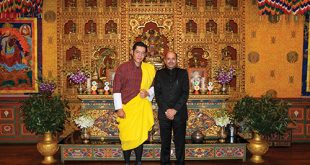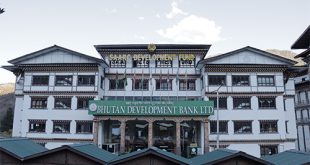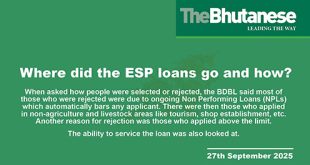The Journalists’ Association of Bhutan (JAB) on 14th August 2025 launched the country’s first ‘Media Perception Index (MPI) Survey Report’.
The survey aimed at assessing and measuring ‘public perceptions, opinions, and attitudes’ toward the media through a list of 78 questions asked by 12 enumerators to 700 respondents in 14 Dzongkhags. The study was done by JAB in collaboration with the Center for Local Governance and Research (CLG) founded by former Parliamentarians.
Opinion or fact
One section of the report was on Media Sources and Credibility which listed all 9 news media houses by name and gave a credibility score against each of them, based on some of the questions above.
The scoring was followed by ‘analysis’ of the scores, and here, things started going awry, especially for The Bhutanese, as a fair amount of the analysis or qualitative descriptions and adjectives were not in line with the 78 listed questions which were quantitative, it was also not in line with the scores and the analysis was not consistent across media outlets. The definitions and explanation of the scores for The Bhutanese was also not consistent with that used for other media houses.
It was not clear if this analysis was derived from the survey data and scores or was the personal opinion of the writers of the report who are the Executive Director of JAB Rinzin Wangchuk and CLG members Sangay Khandu and Nima.
For instance, The Bhutanese did well in the credibility scores collected by the 12 enumerators getting the second highest score among the seven newspapers at 3.73. Kuensel came first at 3.89 among the papers.
The Bhutanese was ranked the third most preferred media in Bhutan after BBS TV and Kuensel based on enumerators scores from within the 78 questions.
The paper also had the most dedicated readership with 11% reporting they read it multiple times a day. The highest for any newspaper.
Despite the good performance of The Bhutanese in media preference, readership and credibility, the ‘analysis’ especially when it came under the credibility section used the strongest negative adjectives, descriptions and insinuations for The Bhutanese, out of the 9 media houses. Descriptions and insinuations that were not listed or measured in the 78 questions. Moreover, there was no quantitative evidence or data listed in the report to support such adjectives for The Bhutanese.
Credibility scores vs ‘analysis’
In the analysis component of the credibility section when it came to The Bhutanese, the report said, “The Bhutanese is viewed as a credible but ‘somewhat polarizing outlet’, with more than one-third of the respondents reserving judgment. While its investigative reporting and independent editorial tone likely contribute to its credibility, the high neutrality score may reflect mixed perceptions about bias, tone, or editorial agenda.”
The report says its 37% neutral score ‘suggests a substantial portion of the public may either be unsure of its objectivity or see it as occasionally credible but not fully consistent’.
The report recommended that The Bhutanese can strengthen its credibility by ‘clarifying its editorial stance, enhancing transparency in reporting, proactively addressing any perceived bias…’. The report also asked The Bhutanese to ‘ensure consistency in tone and objectivity.’
Despite its good score, the limited praise for The Bhutanese is cautious and almost begrudging saying, ‘The data suggests that The Bhutanese enjoys a generally positive, though more cautiously balanced editorial credibility rating among the respondents.’
From the above two paragraphs, it was clear that the report was making strong accusations against The Bhutanese.
Unequal treatment when compared to others
In addition, there was a lack of consistency in definitions of the same scores between The Bhutanese and others.
Under credibility scoring BBS TV’s 4.02 score was made up of 72% high or very high credibility, 23% neutral score and 5% as low credibility.
Kuensel’s 3.89 score had 67% high or very high credibility, 28% neutral score and 6% as low credibility. BBS Radio’s score of 3.79 was made of 62% high or very high credibility, 32% neutral and 7% low credibility.
The Bhutanese’s 3.73 score was made of 58% high or very high credibility, 37% as neutral and 5% as low credibility.
Bhutan Today’s 3.58 score had 50% high or very high credibility, 43% as neutral and 7% as low credibility. Bhutan Time’s 3.57 score had 49% high or very high credibility, 44% as neutral and 6% as low credibility. The Journalist’s 3.49 score had 44% high or very high credibility, 46% as neutral and 9% as low credibility. Gyalchi Sarshog 3.43 score had 40% high or very high credibility, 49% as neutral and 10% as low credibility.
Despite its relatively high score and performance, The Bhutanese elicited the most critical and negative analysis from the above, especially around its 37% neutrality score, but other outlets got a different treatment and application of labels in the analysis, including those with lower scores.
It said the data indicates that BBS TV enjoys strong public credibility, with very few questioning its reliability. The only semi-criticism for its 23% neutral score was ‘while these individuals did not necessarily question its reliability, they may not fully endorse it either possibly pointing to a desire for more balanced content.’
On BBS Radio the report said overall it maintains a favorable credibility profile with the majority of the public viewing it positively. On its 32% neutral score it said, ‘This relatively high neutral segment suggests that while the station is respected, a notable portion of the respondents remain uncertain or less engaged.’
The report said that overall Kuensel commands a solid reputation for credibility within Bhutan’s media landscape, with over two-thirds of the public viewing it positively and only a marginal share expressing distrust. On the 28% neutral score the report said while they did not question its reliability, they may not strongly endorse it either. ‘This neutral sentiment may reflect a cautious view, possibly due to perceived institutional alignment or limited investigative depth.’
In the case of all other private papers, the report is much gentler than the higher performing The Bhutanese as higher neutrality and negative scores are explained away as people being ambivalent, not familiar with them or not engaging enough. The authors of MPI have labled other media houses’ neutral scores as issues with limited engagement and visibility, limited investigative depth, public being unfamiliar with the content. The MPI states that the high neutrality rating “underscroes a pattern seen in many print outlets”.
The report also ignores the fact that negative rating for The Bhutanese is the lowest at 5% along with BBS TV.
If that was not enough, under the Print Media consumption strategy even though the Bhutanese had the most dedicated readership it is accused of focusing on ‘politically-oriented content,’ which is again not supported by the survey, data or facts.
With so many issues, the reporter also noticed that in the credibility section the recommendation section has ‘Recommendation’ typed in bold as a sub heading with proper space kept for every media house except for The Bhutanese where ‘Recommendation’ is not in bold and space is not kept as if like someone did some hurried editing at the last moment, but failed to follow the bold font and spacing.
Analysis not backed by questions or data
Genuinely concerned and intrigued on the disconnect between the high scores and the negative analysis, The Bhutanese checked the list of 78 questions in the annexure of the report to see if questions had been asked about media outlets being polarizing, biased, having a wrong tone, editorial agenda and lacking transparency in reporting.
However, there was not even a single question asking any of the above negative characteristics among the 78 questions meaning the accusations against The Bhutanese was not based on any of the 78 survey questions. It was not clear how JAB and CLG decided to connect these words not applied elsewhere, but just to The Bhutanese when no survey was even done on them.
The issue is larger than one newspaper. If Bhutanese media is to grow stronger, research must be fair, transparent and accountable. Labels like ‘polarizing” have reputational consequences and they cannot be inserted without proof.
The paper then checked the report’s methodology on qualitative data. It says, ‘Responses from open-ended questions were thematically analyzed to identify common themes, perceptions, and suggestions, providing contextual insights that complemented the quantitative findings.’
The paper checked and found no open ended question which encouraged responders to name media outlets and their flaws or asked about the qualitative adjectives used against The Bhutanese.
The only one truly open ended question on the media was question 78 which asked ‘What changes would you like to see in Bhutanese media?’ But here too, no specific media house was named.
This reporter first contacted the JAB Chairman Needrup Zangpo and asked about how the report had arrived at the analysis and qualitative comments. The Chairman said he was not involved in the report and said as far as he knows the questions were all quantitative in nature with no qualitative questions.
The reporter then called the CLG Executive Director Tharchen who also affirmed the questions were quantitative in nature and when asked about the analysis done, he said it had been written down later by the authors as their analysis, and there were no separate qualitative questions for it specifically to measure them.
The paper then contacted Nima and Sangay Khandu asking on what basis the analysis was done in this section.
They said it was based on the quantitative data, a few open ended questions within the 78 questions and some follow up questions on why the respondent gave a particular score. Sangay Khandu said that some of the common words were picked up when the data was entered and it was used too. He, however, admitted there were not too many of these questions and answers.
The paper requested the CLG for access to the Raw survey Data or the information that the responders actually gave to the enumerators and also any other qualitative comments. The paper also asked if CLG could reveal if words like ‘polarizing outlet, bias, tone, editorial agenda, etc.,’ were used when it came to The Bhutanese and if so, how many times.
The CLG asked the reporter to seek the raw data from JAB saying its role was done, and now JAB is the owner of the data.
The aim of seeking the raw data was not to challenge the validity of the entire survey outright, but to conduct deeper analyses, cross-check interpretations, learn what readers think about The Bhutanese, see the level of criticism, if any, and perhaps even use the data to generate follow-up stories on Bhutanese media trends. Unless data is made open and its analysis corrected, MPI risks undermining its objectivity.
JAB denies information
On being contacted, the JAB ED Rinzin Wangchuk initially said sharing the raw data would reveal the identity of the respondents.
The reporter requested for the raw data to be shared after the names are removed which could be done easily online on the spreadsheets with JAB, thus anonymizing the raw data and protecting the identity of the respondents. The ED promised to discuss the matter and get back the next day.
The next day he said, “It won’t be possible. Just like journalists must protect their sources of information, we too have to abide by the terms and conditions set by NSB. We have already discussed this and sharing raw data would be ethically wrong. I hope you will understand. It’s similar to how we deal with newsmakers when they insist on revealing our sources.”
The paper then approached the National Statistical Bureau (NSB) seeking clarity on its ‘terms and conditions’ that JAB claimed to be following to not share the anonymized raw survey data.
A NSB official clarified that its was only concerned with ensuring certain technical parameters like sample size and representation, and the survey and setting of questions was done by JAB (and CLG) and it is up to JAB to share or not with no binding order from NSB not to share it. The official said that if the identity of the respondents is an issue, then the raw data can be anonymized by removing the names and then it should be okay to share.
When asked, the NSB official said that when it does surveys, it avoids adjectives; avoids giving its opinion; avoids qualitative analysis and focuses on hard data and the numbers in line with international best practices. The official said even if an agency wants to do a qualitative study, then it must be based on data collected from the ground and survey questions.
The JAB ED’s contention that it is similar to a newsmaker asking for the source of the information does not make sense, given that The Bhutanese is asking for the information only and not the identity of the source.
Moreover, this is a national level public survey funded by the Department of Media, Creative Industry and Intellectual Property under the Ministry of Industry, Commerce and Employment and not a private venture. Since the MPI was conducted to inform public discourse or policy, the data tranparancy is even more important to avoid perceptions of selective framing. Therefore, releasing the anonymized data that poses no privacy risk, ensures both transperancy and the credibility of the MPI itself.
Though Sangay Khandu earlier said some common words were picked up from entered data for the qualitative analysis, when asked if it was in the computer spreadsheet and can be shared, he said it was not and that it was in some of the physical survey forms in the JAB office.
The paper informed him of JAB’s refusal to share the anonymized raw data, and so as a last ditch effort requested him on Wednesday to talk to JAB and if they don’t want to share the whole data set then to at least list the number of times that words like polarizing outlet, bias, tone, editorial agenda etc., were used in the context of The Bhutanese. On Thursday, despite repeated calls and a message to Sangay Khandu of CLG, there was no response. There was no response on Friday too.
While The Bhutanese was denied, a private media Editor was allowed access by JAB to see a survey form in the JAB office while trying to find out why his paper’s name was not listed in a certain category.
Implications, data openness and ownership
As a media CSO, JAB advocates for access to information and also holds training on media ethics and accurate reporting, but in the above instance, JAB has denied anonymized survey information to a subject of its survey whose credibility is affected by the survey. It has also failed to prove that its analysis around The Bhutanese is in keeping with the 78 questions and the data collected.
This paper is not questioning the entire report, the quantitative data obtained from the field by 12 enumerators through 78 questions that went into the scores and even the mainly positive or neutral analysis for other media outlets, but it is questioning the MPI’s description using strong adjectives and insinuations against The Bhutanese in its ‘analysis’ component which is a departure from the rest and not backed by the 78 questions, hard data and the report itself.
The report has deep implications as even though it will not be widely read, it will be used as an authoritative source for policy decisions, donor reports, news stories and media information and training, and also be used to compile other media reports with the assumption that the information in it is all true backed up by the survey data.
If its qualitative descriptions are not anchored in data then the MPI risks misleading the stakeholders about the Bhutanese media scene.
JAB insists it owns the data by virtue of having commissioned and coordinated the survey. However, the survey was conducted with government funding support. In such cases, data ownership cannot be treated as private property of an association; it becomes a collective resource meant to serve Bhutanese democracy and the public sphere.
Globally, media surveys, academic studies, and research projects supported by public or donor funds often mandate open access to anonymized data. Organizations like Pew Research Center, Reuters Institute, and various UNESCO-backed projects release raw data alongside their reports, enabling independent validation and secondary analysis. This practice not only bolsters trust but also widens the scope of research by allowing others to draw new insights from existing datasets.
JAB’s refusal to follow this norm is not in line with global standards of openness or the values it proclaims to uphold. JAB undermines its own standing as a civil society organization that advocates transparency, media ethics and access to information.
 The Bhutanese Leading the way.
The Bhutanese Leading the way.




